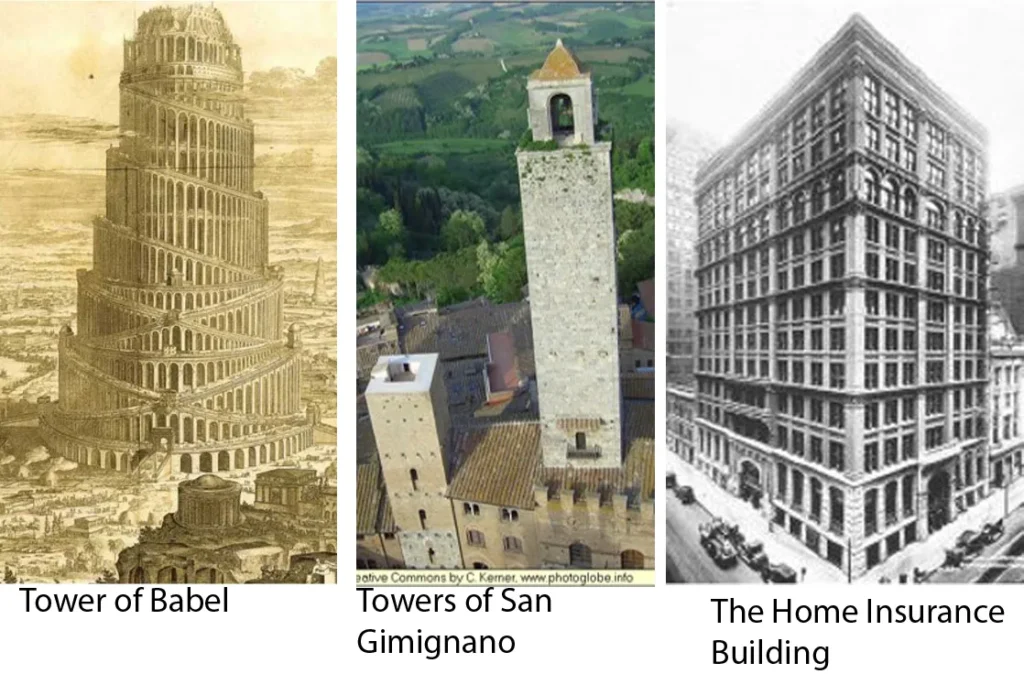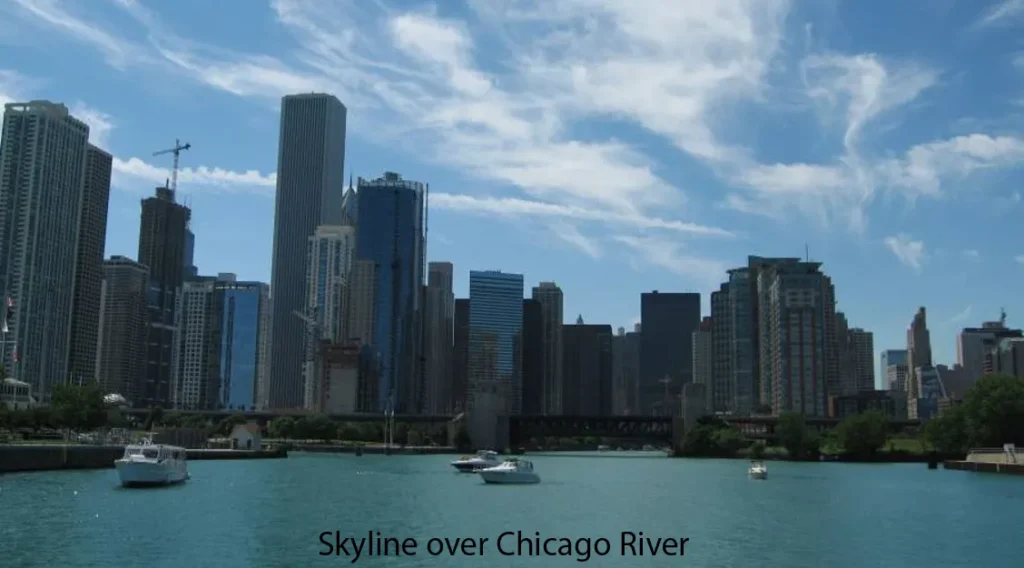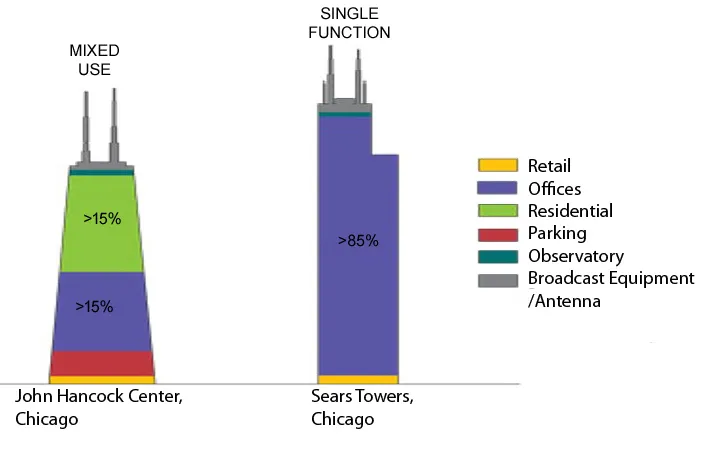If you want to know about objective of design or origin of architecture or what is building services in tall building, please click the link.
Multi-storied buildings are structures that have multiple levels or stories above the ground level. These buildings are designed to provide increased usable floor space in areas where land is limited, and they are a common feature of urban environments. Multi-storied buildings can be used for a variety of purposes, including residential, commercial, and industrial uses.
1) Historical developments of high rise
- Before we start, distinction must be made between “high buildings” and “high-rise buildings”:
“High buildings” have only a few floors and not uncommonly only one, albeit very high floor. They are crowned by a high roof and turrets (in the manner typical of medieval and Gothic cathedrals).
“High-rise buildings”, on the other hand, have many, usually identical floors of normal height one above the other e.g. Towers of San Gimignano.
- The first high-rise office building according to this definition was built in Chicago in 1885: the Home Insurance Building

- It was the rapid growth in population that originally promoted the construction of high-rise buildings. In New York from roughly half a million in 1850, the city’s population grew to 1.4 million by 1899.
- The buildings rose higher and higher with the spread of pioneering construction methods – such as the steel skeleton or reliable deep foundation methods – as well as the invention and development of the elevator.
- More and more skyscrapers rose higher and higher on the solid ground and, New York demonstrated what was meant by “urban densification”.
- Many of the techniques and materials which are also used for “normal” buildings today would never have been invented and would never have become established if high-rise construction had not presented a challenge in terms of technical feasibility.
2) Introduction to high rise developments
- A high-rise is a tall building or structure.
- Buildings between 75 feet and 491 feet (23 m to 150 m) high are, considered high-rises. The average height of a level is around 13 feet (4 m) high, thus a 79 foot (24 m) tall building would comprise 6 floors.
- High-rise buildings became possible with the invention of the elevator and cheaper, more abundant building materials.
- Buildings taller than 492 feet (150 m) are usually classified as skyscrapers.
- A skyscraper taller than 300 meters (984 ft) may be referred to as supertall.

- Shorter buildings are still sometimes referred to as skyscrapers if they appear to dominate their surroundings, depending on the average height of the rest of the buildings and/ or structures in a city.

- Skyscrapers, clearly stands out above its surrounding built environment and significantly changes the overall skyline of that particular city.
- But the definition of the skyscraper does not lie in the height factors but in whether or not the design, operation or urban impact are influenced by the quality of tallness and require special measures in planning, design and construction when compared with buildings representative of ordinary construction.
Following criteria’s define a tall building:
- Net Density
- Mechanical Systems
- Specialized construction and management systems and techniques different from ordinary constructions.
Single-Function and Mixed-Use buildings
- A single-function tall building is defined as one where 85% or more of its total floor area is dedicated to a single usage.
- A mixed-use tall building contains two or more functions, where each of the functions occupy at least 15% of the tower’s total floor area. Ancillary / support areas such as car parks and mechanical plant space do not constitute mixed-use functions.

3) Characteristics of tall building
i) Economics
- Positive – Can prove to be the lowest cost solutions in areas where urban land cost is high. If the land cost for the alternating horizontal structure is too high, the tall buildings may be one way to achieve economical constructions.
- Negative – Can reinforce the upward spiraling of the cost of urban land in cases where the land value is low, high rises can contribute to higher cost per dwelling unit. Initial costs, maintenance costs and operation costs are higher proving the high rises out of the economic rage. Also Lower construction time for low rise as compared to longer times for tall buildings result in high interest costs.
ii) Social and cultural factors
- Positive – High rise apartments are more satisfying to a society which operates with individual or nuclear families, where the individual is accustomed to finding pleasures and satisfactory recreation in public rather than private open spaces.
- Negative – Families where the life style includes intensive use of private open spaces ( walled courtyard), public open areas around a tall building are not a satisfactory substitute and they lack the sense of home ownership. Families of any economic class with small children and elders are concerned about losing eye contact with them while at play and strolls.
iii) Density and Land use
- Positive – In areas where political and geographical boundaries limit the possibilities of horizontal growth but at the same time growing population increases the demand for urban space, tall buildings are the most optimum solution. Also in cases where horizontal growth is possible but not desirable because of precious surrounding agricultural land, high densities can be achieved by building high.
- Negative – Higher construction is not necessarily equivalent to higher densities. Residential building in high rises occupy only 15% proportion of urban land so high rise residential construction cannot alone affect the overall urban density and land consumption.
iv) Symbolism and Prestige
- Positive – Tall buildings provide a sense of social power and prestige and fulfill the natural desire to build upwards. They can create corporate image of economic power and the government image of national progress.
- Negative – Although high-rise may represent job opportunities their size, technological complexity and apparent luxury may intimidate the rural migrant and the urban poor and become symbolic of social polarization.
v) Development control
- Positive – If coordinated with comprehensive master planning these tall buildings can be decisive elements for implementing incremental growth of an urban area. It becomes possible to provide more amenities which can be impractical with smaller concentrations.
- Negative – If not located and constructed in coordination with comprehensive master plan and development schedule, tall buildings create additional problems of urban infrastructure. Tall buildings give limited balconies and surrounding open spaces are converted for public use creating dissatisfaction for people demanding sizable open private spaces.
vi) Transportation
- Positive – Tall buildings make possible a concentration of urban services and transportation reducing the cost and energy, which may be lesser than horizontal transportation required by more medium or low density residential development.
- Negative – If provision is not made in the master plan or existing development does not allow for expansion, large amount of traffic generated by tall buildings can overtax public transportation systems and create extensive automobile traffic.
vii) Urban Environment
- Positive – Tall buildings designed to complement the existing urban environment enhance the cityscape and skyline and become landmarks in themselves.
- Negative – Tall buildings may become objects of visual pollution in urban environment. They may generate uncomfortable winds at street level if not appropriately designed and can alter the city’s micro climate. Refuse, increased pollution by automobile traffic can lower the quality of environment in the nearby areas.
viii) Energy
- Positive – The energy and space utilized per family is reduced quite considerably using lower net surface area and more careful engineering design in a tall building making them more efficient in their use of energy than equivalent low rise constructions.
- Negative – Tall buildings are high consumers of energy in large quantities during construction, operation and maintenance which should be optimally controlled.
ix) Resources and materials
- Positive – In areas where construction industry is geared to large volume productions and availability of resources and materials is available tall building development can be effective. They can be reasons for the development of the area and affect the local labor force.
- Negative – Tall buildings consume a large amount of building materials, particularly steel & cement and sometimes drain these resources away from the necessary development projects. Also higher proportion of skilled labor is required which may have to be brought internationally creating higher local unemployment
x) Safety
- Positive – Because of higher standards of engineering and construction are observed Tall buildings may be less vulnerable to natural forces like earthquakes than low rise structures. They encourage the enforcement of higher engineering standards, greater quality in uniform construction detailing & services & can therefore prove to be more safe.
- Negative – Due to their size, complexity and interdependence of systems risks of potential danger increases and more secure features have to be designed into the building. Crime, vandalism etc are common endangers in high rises.
xi) Esthetics
- Positive – Esthetics is very important in visually representing the character of the city. They act as important elements in defining the various parts of the city, from edges to centers.
- Negative – If proper care is not taken in façade design tall buildings can ruin the otherwise pleasing skyline or crate visual barriers for urban residents. They can alter the character of a historic city or devalue a neighboring building area.
xii) Flexibility
- Positive – Internal design flexibility can provide for future change in use as they are generally multiuse buildings and are more adaptable to change in use as per the changing demand over time
- Negative – Within the individual structure itself, provisions for multiuse flexibility rather than an unchangeable single use may prevent a tall building from becoming obsolete before its structural life is over
4) Reason for high rise developments
The tall building gave:
Shelter
Protection
Privacy
Prestige
- The tendency to “rise above the self” is a fundamental urge satisfied by the development of highrise structures.
- Buildings grew taller to achieve distinction, dominance, & as manifestation of power.
- This rapid development became possible because the technical conditions and methods used in constructing high-rise buildings have improved decisively and changed fundamentally in the last few years.
- Availability of structural materials like steel, concrete and mechanical aids to control the interior environment has increased the scope of highrise buildings.
5) Need for high rise development
- Connections to the infrastructure are improved by concentrating so many people in such a small area. The World Trade Center alone provides jobs for over 50,000 people – that is the equivalent of a medium-sized town. All institutions of public life are united under a single roof and the distances between them have been minimized.
– Many of the techniques and materials which are also used for “normal” buildings today would never have been invented and would never have become established if high-rise construction had not presented a challenge in terms of technical feasibility. Rationalized, automated sequences are beneficial to high-rise buildings; at no time in the past were such huge buildings erected in such a short space of time. Short construction periods also mean shorter financing periods and consequently profits which partly compensate for the additional costs incurred in the construction and finishing of the building.
- Cities in Europe and Asia grew horizontally and it was only when production and services acquired greater economic significance throughout the world and the price of land rose higher and higher in economic centres after the Second World War that they also began to grow vertically.
- This almost inevitably raises the question why high-rise buildings should have to be built in today’s dimensions.
- One reason is indisputably the need for a “landmark”. In other words, to express economic and corporate power and domination in impressive visual terms. Nothing has changed in this respect since the very first high-rise buildings were erected.
– The steadily rising price of land in prime locations and an increasingly scarce supply have made it essential to make optimum use of the air space. Despite their height, however, high-rise buildings still occupy areas of truly gigantic proportions: the ratio of height-to-base width of the cubes in the 417-m-high World Trade Center, for example, is 6:1.
Overall, multi-storied buildings offer a solution to the challenges of population density in urban areas, but their construction and operation require careful planning and management to ensure the safety and well-being of occupants.